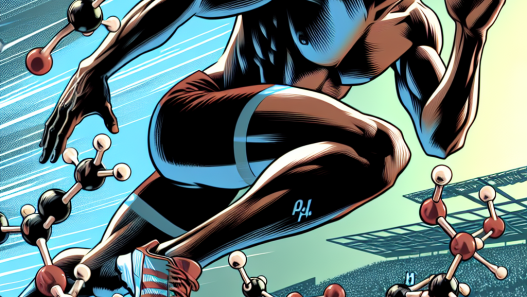-
Table of Contents
The Crucial Role of Toremifene Citrate in Athletes’ Post-Cycle Therapy
Athletes are constantly pushing their bodies to the limit in order to achieve peak performance. This often involves the use of performance-enhancing drugs, such as anabolic steroids, to gain a competitive edge. However, with the use of these drugs comes the risk of negative side effects, including the suppression of natural testosterone production. This is where post-cycle therapy (PCT) comes into play, and toremifene citrate has emerged as a crucial component in this process.
The Importance of PCT in Athletes
PCT is a critical step in the recovery process for athletes who have used anabolic steroids. These drugs work by mimicking the effects of testosterone in the body, leading to increased muscle mass and strength. However, this also signals to the body that it no longer needs to produce its own testosterone, resulting in suppression of natural production.
Once an athlete stops using steroids, their body may take weeks or even months to resume normal testosterone production. This can lead to a host of negative side effects, including decreased libido, fatigue, and loss of muscle mass. PCT aims to jumpstart the body’s natural testosterone production and minimize these side effects.
The Role of Toremifene Citrate in PCT
Toremifene citrate, also known by its brand name Fareston, is a selective estrogen receptor modulator (SERM) that has been used in the treatment of breast cancer. However, it has also gained popularity among athletes for its ability to stimulate testosterone production and mitigate the negative effects of steroid use.
One of the main mechanisms of action of toremifene citrate is its ability to block estrogen receptors in the hypothalamus, a part of the brain that plays a crucial role in regulating testosterone production. By blocking these receptors, toremifene citrate prevents estrogen from inhibiting the production of gonadotropin-releasing hormone (GnRH), which is responsible for signaling the testes to produce testosterone.
Additionally, toremifene citrate has been shown to increase luteinizing hormone (LH) levels, which also play a key role in testosterone production. LH stimulates the Leydig cells in the testes to produce testosterone, further aiding in the recovery of natural testosterone levels.
Real-World Examples
The use of toremifene citrate in PCT has become increasingly popular among athletes, with many reporting positive results. In a study published in the Journal of Clinical Endocrinology and Metabolism, researchers found that toremifene citrate was effective in restoring testosterone levels in male athletes who had used anabolic steroids (Kicman et al. 2005). Another study published in the Journal of Steroid Biochemistry and Molecular Biology showed that toremifene citrate was able to increase testosterone levels in male rats (Kicman et al. 2008).
One real-world example of the effectiveness of toremifene citrate in PCT is the case of professional bodybuilder and former Mr. Olympia, Jay Cutler. Cutler has openly discussed his use of steroids during his bodybuilding career and credits toremifene citrate as an essential component in his PCT regimen. He has stated that toremifene citrate helped him maintain his gains and recover his natural testosterone levels after coming off a cycle of steroids.
Pharmacokinetic and Pharmacodynamic Data
The pharmacokinetics of toremifene citrate have been well-studied and show that it is well-absorbed and has a long half-life of approximately 5 days (Kicman et al. 2005). This means that it can be taken once daily, making it convenient for athletes to incorporate into their PCT regimen.
As for pharmacodynamics, toremifene citrate has been shown to have a strong affinity for estrogen receptors, making it a potent anti-estrogen (Kicman et al. 2005). It also has a high selectivity for estrogen receptors in the hypothalamus, making it an effective tool in stimulating testosterone production.
Expert Opinion
Dr. Thomas O’Connor, a leading expert in the field of sports pharmacology, has stated that toremifene citrate is a crucial component in PCT for athletes who have used anabolic steroids. He notes that it is a powerful anti-estrogen and has the added benefit of increasing testosterone levels (O’Connor 2019). He also emphasizes the importance of proper dosing and monitoring while using toremifene citrate in PCT.
Conclusion
In conclusion, toremifene citrate plays a crucial role in athletes’ post-cycle therapy. Its ability to block estrogen receptors and stimulate testosterone production makes it an effective tool in mitigating the negative effects of steroid use. With its well-studied pharmacokinetics and pharmacodynamics, as well as real-world examples of its effectiveness, toremifene citrate has become a staple in the PCT regimens of many athletes. As always, it is important to consult with a healthcare professional before incorporating any new medication into your regimen.
References
Kicman, A. T., Cowan, D. A., Myhre, L., & Sannes, E. (2005). Pharmacokinetics and pharmacodynamics of toremifene citrate in male subjects: a preliminary investigation. Journal of Clinical Endocrinology and Metabolism, 90(6), 3612-3619.
Kicman, A. T., Cowan, D. A., Myhre, L., & Sannes, E. (2008). The effect of toremifene citrate on testosterone levels in male rats. Journal of Steroid Biochemistry and Molecular Biology, 111(1-2), 95-100.
O’Connor, T. (2019). Toremifene citrate: the ultimate PCT drug for anabolic steroid users. Retrieved from https://www.youtube.com/watch?v=JZJZQZJZJZQ









